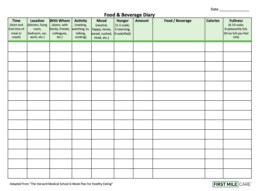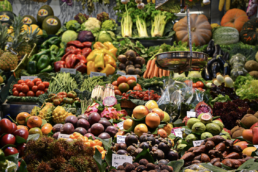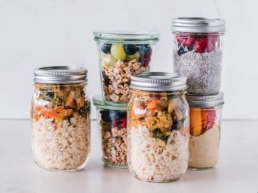By Karalyn Cass, First Mile Care, DPP Coach
The COVID-19 pandemic has disrupted our lives in so many ways. Your eating habits have undoubtedly changed from what they were in pre-coronavirus days. You may be eating more home-cooked food, but also snacking throughout the day to combat stress, boredom, or loneliness.
Keeping a food journal is an effective tool to help you learn about your “new normal.” Not only does food journaling track the calories you consume, it reveals trends and patterns in your eating habits that affect your risk of developing type 2 diabetes. It highlights the foods and beverages you most often consume, how much is healthy versus unhealthy, and the link between what you eat and your emotional state. That information will help you to evaluate your behaviors and set reachable goals for changing them. In fact, a research study involving 1,700 participants determined that the people who kept daily food logs lost twice as much weight as the people who didn’t track their food intake at all.
There is also an accountability factor to food journaling. It may subconsciously discourage you from careless eating because you have to write down every snack in your food log. If you’re in the First Mile Care Diabetes Prevention Program (DPP), you’ll also discuss your journal findings with your DPP coach and neighborhood class participants, who can help you come up with strategies to cope with your eating triggers. Food journaling is a great self-discovery tool that helps you to investigate your relationship with food and its connection to your mood.
How to keep a food journal
Some people believe food journaling can be tedious. However, the self-discovery is so eye-opening that many people love it. For basic tracking of your food intake, you can go the traditional route of using paper and pencil to keep a food log.
You can also use the voice recording feature on your phone. A convenient digital way to track your food intake is through apps on your smartphones and computers. Lose It!, My Plate, and MyFitnessPal, among others, allow you to note your activities and track calories by breaking down ingredients into carbohydrates, proteins and fats. There are even photo-recognition apps now such as Foodvisor and Bitesnap that can calculate the calories of the food in a photo of your meal.
Whether it’s a paper spreadsheet, an app, or a combination of the two, it’s important that you keep a food journal for at least a week to become familiar with your true eating habits. Making journal entries as soon as possible after eating will result in more accurate details.
8 questions to ask yourself when food journaling
Food journaling goes beyond mere meal tracking. It’s not simply about counting calories. Journaling is connecting the dots between what you eat and how you feel throughout the day — both your food and your mood. You’ll track details about your meals and snacking such as the time of day, where you are, who you’re eating with, how hungry you are, and how quickly you become full.
Record answers to these eight questions in your food journal:
1. What are you eating? Not only do you record the food or the beverage that you’re consuming, but also any of the sauces, dressings, condiments, and toppings. Your caramel macchiato has vanilla syrup and steamed milk as well as coffee. The preparation details of your meat and vegetables are important — was it baked, boiled, fried, grilled or steamed?
2. How much are you eating? Try your best to estimate how much you are eating using standard household measurements (cups, ounces, teaspoons). Try weighing your food for a trial period to get a better idea of your servings. Some smartphone apps have databases that will do calorie calculations for you.
3. When are you eating? The time of day that you eat can be very insightful in identifying potentially problematic behaviors such as late-night snacking or that midday slump. Knowing exactly when you are most likely to feel hungry is important for adjusting your eating schedule and frequency, so you can avoid overeating as a result of waiting too long to eat.
4. Where are you eating? Take note of the location of where you eat — whether it’s your dining table, the living room, your office, your car, a restaurant, a friend’s house, or even walking down the street.
5. What are you doing while you’re eating? Multitasking and eating can be a recipe for disaster. It can make it easy to ignore your body’s signals telling you that you’re full. Try eating a meal without TV and phone screens as a distraction, so that you concentrate on the taste and texture of every bite of your meal.
6. Who are you eating with? Americans eat and drink alone more than half the time, according to research. Studies have also found that solo diners are also more likely to eat at irregular times and consume unhealthier foods with fewer fruits and vegetables. Eating with others tends to put you on a schedule and to eat more slowly while conversing. People also take cues from dining companions as to what to eat, and how much.
7. How are you feeling while you’re eating? Are you eating when you’re tired, bored, frustrated, anxious, sad or happy? You may find that you’re eating when your emotions tell you to eat rather than when your body tells you, or that your mood is affected by hunger. Think of being “hangry,” when you’re grumpy-angry because you’re hungry.
When you’re feeling stressed or depressed, it’s normal to crave unhealthy, high-calorie treats. During the COVID-19 shutdown, grocers are seeing a surge in demand for sugary cereals, frozen pizza, mac and cheese, salty chips, and other processed “comfort foods.” Unfortunately, stress-eating can become a vicious cycle as fat and sugar only increase the likelihood of depression and anxiety, which then causes you to want more junk food to stave off your dark mood. But keep in mind that just as unhealthy food can contribute to depression, healthy food can boost your mood.
8. How hungry and how full are you?
It’s important to be mindful of your hunger cues so that you pay attention to true, physical hunger and not the hunger that’s in your head caused by emotions. Your body naturally tells you when you’re hungry, and warns you when it’s time to stop eating. In your food journal, rate your hunger level every time you eat on a “hunger scale” between 1 and 10, where 1 is starving and 10 is so full that you feel sick. To eat naturally, the way a baby eats, you want to eat when your hunger is at a 3 or 4. It takes about 20 minutes for your brain to recognize that you’ve eaten enough, so to avoid overeating, slowing down eating and even stopping to assess your hunger level mid-meal will give your body time to catch up.
Fitting food journaling into your life
After completing a week of food journaling, look for trends across the data in your food journal. Are you making healthy choices? Are you reaching for a snack when you’re bored? Do you overeat when having a meal in the kitchen near the fridge? How often are you eating while on the run? Is watching TV a trigger for evening snacking? Should you eat more frequently to avoid overeating when you’re extremely hungry?
The longer you keep a food journal, the more you’ll discover about your eating habits. You will then be able to create a successful strategy for recognizing your hunger cues and consistently make healthy choices. Give mood-food journaling a try!
To learn more about how you can benefit from the First Mile Care Diabetes Prevention Program, take our prediabetes risk test and get started today!




